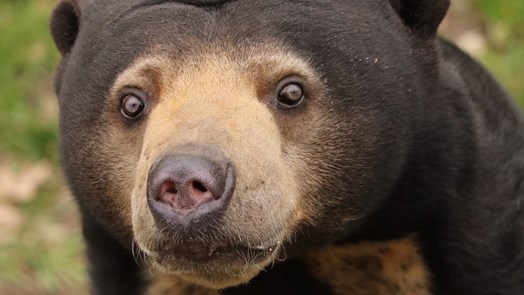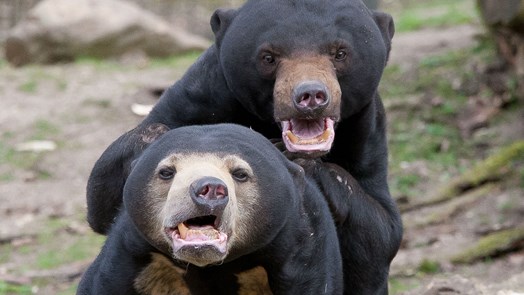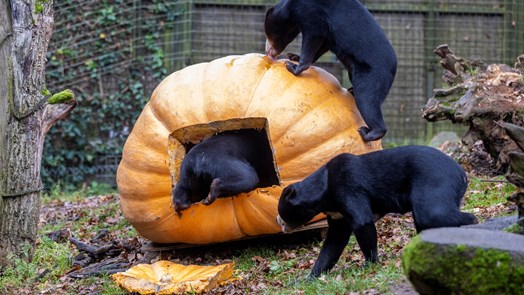What is an eco-display? The Rimba
Friday, 10 June 2022

Burgers’ Zoo is known for its eco-displays: nature reserves where animals often live in great freedom amidst thousands of plants, and visitors can experience such a habitat up close. An eco-display is designed to imitate a specific ecosystem as realistically as possible. What does that mean in practice? What are some of the characteristic features of an eco-display? What do biologists and designers need to consider when designing an eco-display? What challenges do they face? In this series, we focus on the essence of each eco-display through practical examples. This time: the Rimba.
In the Rimba, visitors learn about various larger animal species from Southeast Asia. ‘Rimba’ means ‘jungle’ in Malay. Even though the Bush would be perfect for these animals in terms of the biotope, it is unsuitable for various other reasons. They couldn’t roam free and would have to live in very restricted areas. Sumatran tigers and Malayan bears would be dangerous to visitors and many other animal inhabitants, while monkeys, deer and cattle would cause a lot of damage to the vegetation. Several monkey species like to steal eggs from nests, and the technology in the eco-display would suffer greatly from their curious and inventive behaviour. These are just several reasons why these larger species are unsuitable for the Bush.

In choosing the collection, the biologists looked primarily at endangered species. Unfortunately, many species in South-East Asia have been displaced by over-hunting and habitat loss, and much-needed population management programmes have been established for many species in that region. This also applies to species such as the Eld’s deer and the Indian hog deer, which, at first glance, are not the biggest crowd-pullers. Zoos are always looking for places to increase the necessary, safe reserve population for these species. We are happy to provide the space and thus contribute to the conservation of endangered species. The Rimba is also about educating people on endangered animals, which observant visitors will notice on the information boards.

The Rimba is largely in the open air. In our more expansive animal enclosures, we sometimes combine different animal species in one enclosure. A successful example of such an enclosure is where the macaques, siamangs, Eld’s deer, Indian hog deer, muntjacs and bantengs live together. We have used some visual tricks here and there as well. For example, the siamangs and the macaques cannot reach each other, although it looks like they can. The feeding areas for the vegetable and grass eaters are also separated. Animals that naturally eat grass often also like various vegetables, which are less suitable for their adapted digestive systems. The sun bears and binturongs used to be on exhibit together, but things changed when we had a new female binturong that kept climbing out of the trees to approach the bears. When the two female sun bears had cubs, they became more vigilant toward the binturongs. The bears can now be seen in the enclosure during the day, and the nocturnal and crepuscular (active during twilight) binturongs enter the enclosure in the evening. Sometimes, the success of communal living depends on individual animals or specific developments in a particular species.

In the design of the Rimba, we carefully considered visitor sightlines and how visitors see the animals. To create a more intense experience, we deliberately ensured that visitors cannot see other visitors at certain locations. Winding paths lead them on a journey of discovery through this area, using conveniently positioned plants to keep animals and other people out of sight. We even managed to save space where the main route enters a cave; the Asian water monitors’ and reticulated pythons’ enclosures run under the tiger enclosure. The off-exhibit indoor enclosures and additional outdoor enclosures near the tigers are conveniently hidden from sight. The same applies to the stables for the ungulates (deer and cattle) and the walkway behind them. The sun bears have an indoor enclosure where visitors can see the animals, but several off-exhibit indoor areas are also available. Two indoor enclosures have a special nursery where the bears can give birth.

Although all the animals in the Rimba were born in zoos, they are originally tropical species that are not always able to withstand our Dutch winters. The tigers, bears, monkeys and reptiles all require heated indoor enclosures. The tigers’ outdoor enclosure also has heated caves, but they stay in their heated indoor enclosure or go out later in the day when it gets too cold. The bears can be viewed in their heated indoor enclosure thanks to large windows, and the reticulated pythons and Asian water monitors only have an indoor enclosure. Special daylight and UV lamps provide sufficient light in the right wavelength for these animals. The golden-cheeked gibbons are relatively hardy, perhaps surprisingly so at first sight. In the wild, the gibbon genus Nomascus used to have a much bigger species distribution to the north, toward China, and it can get pretty cold there!

We had no choice but to make concessions to the Dutch climate for the vegetation in the Rimba. We try to display Asian plant species from more northern regions and species that may not come from the Asian forest but have a tropical appearance. Below are several examples of creative plant choices to create the right atmosphere in the Rimba; there are many more. Bamboo (Bambus japonica) is typical for Asia. At the entrance to the Rimba, on the right, before the bear enclosure, you can see the peanut butter tree or glorytree from China (Chlerodendron trichotomum). It is related to the pagoda flower in the Bush and is the only Dutch winter representative of its genus. The tree’s leaves smell like peanut butter when touched.
Crinium (Crinum sp) has recently been planted opposite the deer meadow; these are relatives of the amaryllis and originate from Africa. This section also houses the goldenrain tree (Koelreuteria paniculata) from China, Japan and Korea. With its yellow bunches of flowers in summer and lantern-like fruits, this plant is a sight to behold. Chinese bean trees (Catalpa fargesii), with their striking blossoms and strong scent in summer, grow throughout the Rimba. You can find Japanese dogwood (Cornus kousa) growing between the two Red List signs. In June, flowers appear on this shrub, mainly noticeable because of their four white bracts; they are a kind of “fake flower”. The red fruits in autumn are edible, although the skin is bitter. Dogwood naturally grows in Korea, China and Japan.

Bambus japonica
We considered many things in the design and construction of the Rimba eco-display to ensure visitors a colourful adventure that leads them past Southeast Asia’s charismatic, larger animal species.


